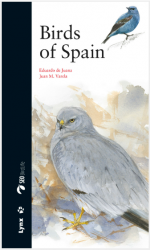John Cantelo
Well-known member
Despite my very limited Spanish I've always recommended Eduardo de Juana & Juan Varela's "Aves de España" since the excellent illustrations and maps are both multi-lingual ;-) (the illustrations also larger than the norm and the maps able to show more detail). Information about populations and seasonal movements aren't to hard to figure out either. The good news is that an English language version will be out next month for 25.00€. Unfortunately, I fear that it will use the same counterintuitive order as the latest Spanish edition which may be scientifically 'pure' but is entirely dysfunctional in a field guide. I also think that the publishers may have missed a trick since as it's now in English, ornithology's lingua franca, it would have better to have upgraded it to 'Birds of Iberia' which would have attracted more sales from ex-pats in Portugal.
http://www.lynxeds.com/product/birds-spain
http://www.lynxeds.com/product/birds-spain








